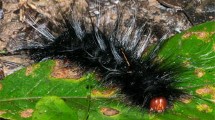Abstract
Mycophagy (fungus-feeding) by Japanese macaques (Macaca fuscata yakui) in Yakushima has been observed by many researchers, but no detailed information is available on this behavior, including which fungal species are consumed. To provide a general description of mycophagy and to understand how and whether macaques avoid poisonous fungi, we conducted behavioral observation of wild Japanese macaques in Yakushima and used molecular techniques to identify fungal species. The results indicate that the diet of the macaques contains a large variety of fungal species (67 possible species in 31 genera), although they compose a very small portion of the total diet (2.2 % of annual feeding time). Fungi which were eaten by macaques immediately after they were picked up were less likely to be poisonous than those which were examined (sniffed, nibbled, carefully handled) by macaques. However, such examining behaviors did not appear to increase the macaques’ abilities to detect poisonous fungi. Fungi that were only partially consumed included more poisonous species than those fully consumed with/without examining behavior, yet this was not significant. Taste, therefore, might also play an important role in discriminating poisonous from non-poisonous.



Similar content being viewed by others
References
Agetsuma N, Noma N (1995) Rapid shifting of foraging pattern by Yakushima macaques (Macaca fuscata yakui) in response to heavy fruiting of Myrica rubra. Int J Primatol 16:247–260
Agrahar-Murugkar D, Subbulakshmi G (2005) Nutritional value of edible wild mushrooms collected from the Khasi hills of Meghalaya. Food Chem 89:599–603
Bermejo M, Illera G, Pí JS (1995) Animals and mushrooms consumed by bonobos (Pan paniscus): new records from Lilungu (Ikela), Zaire. Int J f Primatol 16:879–898
Camazine S, Resch J, Eisner T, Meinwald J (1983) Mushroom chemical defense. J Chem Ecol 9:1439–1447
Eren SH, Demirel Y, Ugurlu S, Korkmaz I, Aktas C, Güven FMK (2010) Mushroom poisoning: retrospective analysis of 294 cases. Clinics 65:491–496
Hanson AM, Hodge KT, Porter LM (2003) Mycophagy among primates. Mycology 17:6–10
Hanson A, Hall M, Porter L, Lintzenich B (2006) Composition and nutritional characteristics of fungi consumed by Callimico goeldii in Pando, Bolivia. Int J Primatol 27:323–346
Hanya G (2004) Diet of a Japanese Macaque troop in the coniferous forest of Yakushima. Int J Primatol 25:55–71
Harrison M (1984) Optimal foraging strategies in the diet of the green monkey, Cercopithecus sabaeus, at Mt. Assirik, Senegal. Int J Primatol 5:435–471
Hilário RR, Ferrari SF (2010) Feeding ecology of a group of buffy-headed marmosets (Callithrix flaviceps): fungi as a preferred resource. Am J Primatol 72:515–521
Hill DA (1997) Seasonal variation in the feeding behavior and diet of Japanese macaques (Macaca fuscata yakui) in lowland forest of Yakushima. Am J Primatol 43:305–320
Imazeki R, Otani Y, Hongo T (1988) Fungi of Japan. Yama-Kei Publishers (in Japanese), Tokyo
Ishihara Y, Yamaura Y (1992) Descriptive epidemiology of mushroom poisoning in Japan (in Japanese). Jpn J Hyg 46:1071–1078
Johnson CN (1996) Interactions between mammals and ectomycorrhizal fungi. Trends Ecol Evol 11:503–507
Lehmkuhl JF, Gould LE, Cázares E, Hosford DR (2004) Truffle abundance and mycophagy by northern flying squirrels in eastern Washington forests. For Ecol Manag 200:49–65
Murakami Y (1989) Spatial changes of species composition and seasonal fruiting of the Agaricales in Castanopsis cuspidate forest. Trans Mycol Soc Jpn 30:89–103
Porter L (2001) Dietary differences among sympatric Callitrichinae in Northern Bolivia: Callimico goeldii, Saguinus fuscicollis and S. labiatus. Int J Primatol 22:961–992
Porter LM, Garber PA (2004) Goeldi’s monkeys: a primate paradox? Evol Anthropol 13:104–115
Rowe N, Mittermeier RA (1996) The pictorial guide to the living primates. Pogonias Press, East Hampton
Sato H, Murakami N (2008) Reproductive isolation among cryptic species in the ectomycorrhizal genus Strobilomyces: population-level CAPS marker-based genetic analysis. Mol Phylog Evol 48:326–334
Sherratt TN, Wilkinson DM, Bain RS (2005) Explaining Dioscorides’ “double difference”: why are some mushrooms poisonous, and do they signal their unprofitability? Am Nat 166:767–775
Tsujino R, Sato H, Imamura A, Yumoto T (2009) Topography-specific emergence of fungal fruiting bodies in warm temperate evergreen broad-leaved forests on Yakushima Island, Japan. Mycoscience 50:388–399
Unluoglu I, Tayfur M (2003) Mushroom poisoning: an analysis of the data between 1996 and 2000. Eur J Emerg Med 10:23–26
Watts DP (1984) Composition and variability of mountain gorilla diets in the Central Virungas. Am J Primatol 7:323–356
White TJ, Bruns T, Lee S, Taylor J (1990) Amplification and direct sequencing of fungal ribosomal RNA genes for phylogenetics. In: Innis MA, Gelfand DH, Sninsky JJ, White TJ (eds) PCR protocols: a guide to methods and applications. Academic Press, San Diego, CA, pp 315–322
Yamagiwa J (2008) History and present scope of field studies on Macaca fuscata yakui at Yakushima Island, Japan. Int J Primatol 29:49–64
Acknowledgments
The authors would like to express their gratitude to Drs. K. Watanabe, T. Furuichi, H. Imai and E. Sakaguchi for their great advice for this study. We are grateful to the members of the Department of Ecology and Social Behavior for their informative comments and advice. We are thankful to Mr. T. Saito for his great help in establishing phenology plots and to Yakushima Forest Environment Conservation Center and Kagoshima Prefectural Government for permission to carry out field research and sample collection on Yakushima. We also thank all our colleagues and friends who visited and stayed at Yakushima Field Station, Wildlife Research Center of Kyoto University, for sharing their valuable information and insights. This study was financially supported by JSPS/MEXT Grant-in-Aid for JSPS Fellows (No. 225374) to AS, JSPS-MEXT Grant-in-Aid for Challenging Exploratory Research (No. 23657018) and for Young Scientists (No. 20770195) to GH, and Global COE Program “Formation of a Strategic Base for Biodiversity and Evolutionary Research: from Genome to Ecosystem”. This research adhered to the guidelines established by KUPRI and the legal requirements in Japan.
Author information
Authors and Affiliations
Corresponding author
Electronic supplementary material
Below is the link to the electronic supplementary material.
About this article
Cite this article
Sawada, A., Sato, H., Inoue, E. et al. Mycophagy among Japanese macaques in Yakushima: fungal species diversity and behavioral patterns. Primates 55, 249–257 (2014). https://doi.org/10.1007/s10329-013-0396-9
Received:
Accepted:
Published:
Issue Date:
DOI: https://doi.org/10.1007/s10329-013-0396-9




